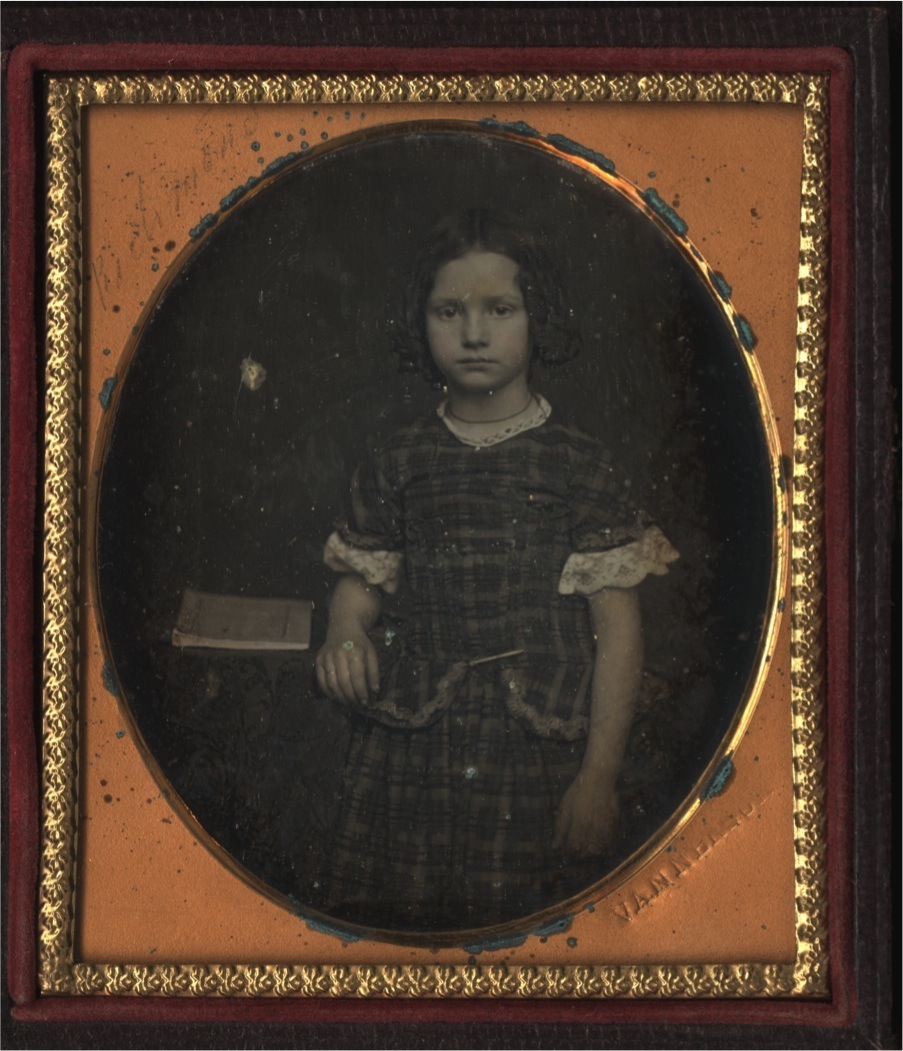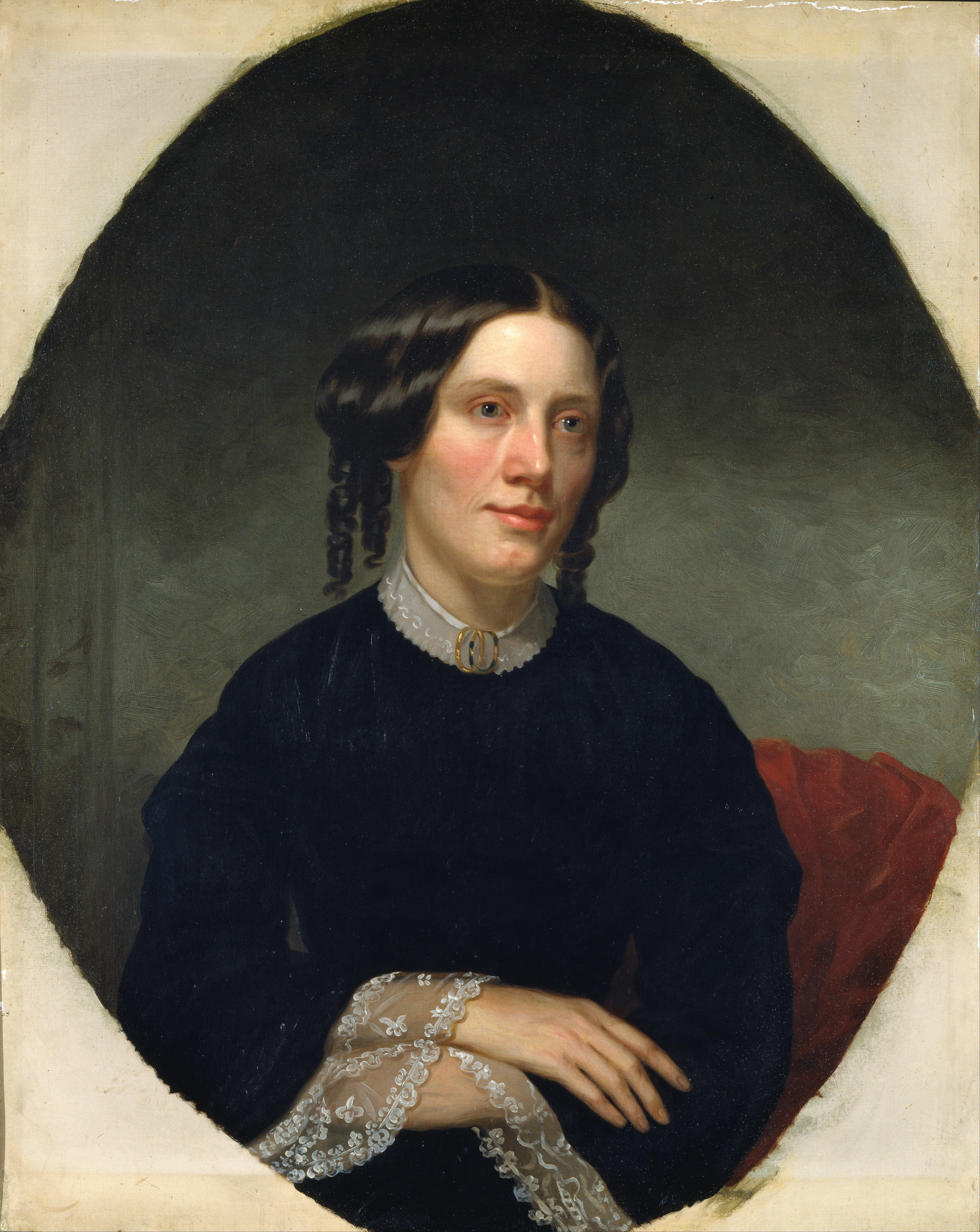|
Garafilia Mohalbi
Garafilia Mohalbi(y) (; 1817 – March 17, 1830) was a Greek slave that was rescued by an American merchant and sent to live with his family in Boston, Massachusetts. Born to a prominent family on the island of Psara, her parents were killed in 1824 during the Destruction of Psara by the Turks. She arrived in Boston around the same period Samuel Gridley Howe brought John Celivergos Zachos and Christophorus Plato Castanis and other Greek refuges. She died aged thirteen. After her death, she became a popular celebrity in the media and among abolitionists. History Garafilia Mohalbi was born to a prominent Greek family on the island of Psara. Her parents were killed in 1824 during the Destruction of Psara by the Turks. Mohalbi and her sisters were kidnapped and sold into slavery. At the age of ten, she was working as a slave to a Turkish family in Smyrna. At a bazaar in Smyrna, she met American merchant Mr. Langdon and begged him to rescue her from bondage. He purchase ... [...More Info...] [...Related Items...] OR: [Wikipedia] [Google] [Baidu] |
Edward Gallaudet (engraver)
Edward Gallaudet (April 30, 1809 – October 11, 1847) was an American nineteenth-century engraver. History Edward Gallaudet was the twelfth son of Peter Wallace Gallaudet the personal secretary to US President George Washington while his office was in Philadelphia. Peter Wallace Gallaudet was the nephew of Elisha Gallaudet, the engraver of the first US coin, the 1776 Continental Dollar. Gallaudet was an apprentice engraver in Hartford, Connecticut. He then moved to Boston where he worked with John Cheney. He was a reputable line engraver and his best work was between 1835 and 1840. He also worked in New York City. He died at 38 years old. Notable works Around 1830, Edward Gallaudet engraved Ann Halls miniature portrait of ''Garafilia Mohalbi''. The engraving became extremely popular throughout the United States and became Ann Halls most popular work. Notable poet Hannah Flagg Gould wrote a poem about Gallaudet's engraving. The ''Progress of Intemperance'' is another engr ... [...More Info...] [...Related Items...] OR: [Wikipedia] [Google] [Baidu] |
:Template:Infobox Writer/doc
Infobox writer may be used to summarize information about a person who is a writer/author (includes screenwriters). If the writer-specific fields here are not needed, consider using the more general ; other infoboxes there can be found in :People and person infobox templates. This template may also be used as a module (or sub-template) of ; see WikiProject Infoboxes/embed for guidance on such usage. Syntax The infobox may be added by pasting the template as shown below into an article. All fields are optional. Any unused parameter names can be left blank or omitted. Parameters Please remove any parameters from an article's infobox that are unlikely to be used. All parameters are optional. Unless otherwise specified, if a parameter has multiple values, they should be comma-separated using the template: : which produces: : , language= If any of the individual values contain commas already, add to use semi-colons as separators: : which produces: : , ps ... [...More Info...] [...Related Items...] OR: [Wikipedia] [Google] [Baidu] |
Hiram Powers
Hiram Powers (July 29, 1805 – June 27, 1873) was an American neoclassical sculptor. He was one of the first 19th-century American artists to gain an international reputation, largely based on his famous marble sculpture ''The Greek Slave''. Early life and studies Powers was born to a farmer on July 29, 1805 in Woodstock, Vermont. When he was 14 years old, his family moved to Ohio, about six miles from Cincinnati, where Powers attended school for about a year while staying with his father's brother, a lawyer. He began working after the death of his parents, first superintending a reading-room in connection with the chief hotel of the town, then working a clerk in a general store. At age 17, Powers became an assistant to Luman Watson, Cincinnati's early wooden clockmaker, who owned a clock and organ factory. Using his skill in modeling figures, Powers mastered the construction of the instruments and became the first mechanic in the factory. In 1826 he began to frequent the st ... [...More Info...] [...Related Items...] OR: [Wikipedia] [Google] [Baidu] |
Mary Mildred Williams
Mary Mildred Williams (born Botts, c. 1847 - 1921) was born into slavery in Virginia and became widely known as an example of a "white slave" in the years before the American Civil War, Civil War. In 1855, her escaped father bought his family's freedom with financial aid from abolitionists, and she, her mother and siblings joined him in Boston, Massachusetts. After arriving in Boston at the age of seven, Williams's photograph became widely distributed, as her appearance was startling for people who usually classified slaves as "Other (philosophy), Other". The young girl toured with abolitionist Charles Sumner, US Senator from Massachusetts. He used her as an example to confront Northerners with the injustice of slavery, and to raise awareness and raise funds for the abolitionist cause. Williams was compared to ''Ida May'', the main character in a popular novel of that name; she was a white girl who was kidnapped and sold into slavery. Early life Born Mary Mildred Botts in 1847 ... [...More Info...] [...Related Items...] OR: [Wikipedia] [Google] [Baidu] |
Joseph Stephanini
Joseph Stephanini ( el, Ιωσήφ Στεφανίνις; 1803–?) was an Ottoman Greek author and runaway slave. He migrated to the United States. He wrote ''The Personal Narrative of the Sufferings of J. Stephanini'' pleading to the American people to raise money to free his family from the bondage of slavery. The book began to circulate in the United States in the early 1830s. Many American's learned about the horrors of Ottoman slavery. The Greek Slave Movement evolved and American abolitionists used the subject matter. The most notable subject of the Greek Slave Movement was The Greek Slave statue by Hiram Powers. Early life Stephanini was born in Arta to Ioannis and Chrissavi Themiano. They were married at fourteen years old. They had seven children: Joseph, Spiro, Demetri, Sylvestro, Maria, Catharina, and Anna. Joseph's father was a very wealthy merchant. The family eventually moved to Patras. The city primarily dealt with Italian merchants. Stephanini learned th ... [...More Info...] [...Related Items...] OR: [Wikipedia] [Google] [Baidu] |
George Colvocoresses
George Musalas "Colvos" Colvocoresses (October 22, 1816 – June 3, 1872) was a Greek-American United States Navy, Navy officer who commanded the during the American Civil War. From 1838 up until 1842, he took part in the United States Exploring Expedition, which explored large regions of the Pacific Ocean. Biography Early life He was born on the island of Chios in the Greek Archipelago on October 22, 1816. As a member of a prominent Greek family, he was kidnapped along with his mother and two sisters and ransomed from the Turks after Chios Massacre, the massacre of the Greek population of the island in 1822, during the Greek War of Independence. His family's fortunes were devastated by the massacre. Most close relatives, including six brothers, were killed. He was enslaved at 6 years of age, but his father managed to buy back his freedom. By 1824, Colvocoresses was sent to Baltimore in the United States by his father. He became the adopted son of Captain Alden Partridge, t ... [...More Info...] [...Related Items...] OR: [Wikipedia] [Google] [Baidu] |
Christophorus Castanis
Christophorus Plato Castanis ( el, Χριστόφορος Πλάτων Καστανής; 1814–1866; also known as Christophoros Castanis or Castanes and Christoforos Kastanis or Kastanes) was an Ottoman Greek academic, author and classicist. Castanis was born at Livadia, Chios on 1 April 1814 and lived much of his life in the United States. He published an autobiography titled ''The Greek Exile'' in 1851, which told of his survival of the Chios massacre, his time in Ottoman slavery, and his emigration to America. Personal life Castanis was born to a wealthy Chiot family, and was one of eight siblings.Castanis, ''The Greek Exile'', 21. He was privately educated and one of his tutors was a member of the Filiki Eteria. In 1822, during the Chios massacre, Castanis was captured and sold into slavery, where he was forcibly converted to Islam. According to his autobiography, Castanis made an escape and was reunited with his mother. They eventually fled on a Cephalonian ship and met ... [...More Info...] [...Related Items...] OR: [Wikipedia] [Google] [Baidu] |
Uncle Tom's Cabin
''Uncle Tom's Cabin; or, Life Among the Lowly'' is an anti-slavery novel by American author Harriet Beecher Stowe. Published in two volumes in 1852, the novel had a profound effect on attitudes toward African Americans and slavery in the U.S., and is said to have "helped lay the groundwork for the mericanCivil War". Stowe, a Connecticut-born woman of English descent, was part of the religious Beecher family and an active abolitionist. She wrote the sentimental novel to depict the reality of slavery while also asserting that Christian love could overcome slavery. The novel focuses on the character of Uncle Tom, a long-suffering black slave around whom the stories of the other characters revolve. In the United States, ''Uncle Tom's Cabin'' was the best-selling novel and the second best-selling book of the 19th century, following the Bible. It is credited with helping fuel the abolitionist cause in the 1850s. The influence attributed to the book was so great that a likely ... [...More Info...] [...Related Items...] OR: [Wikipedia] [Google] [Baidu] |
Harriet Beecher Stowe
Harriet Elisabeth Beecher Stowe (; June 14, 1811 – July 1, 1896) was an American author and abolitionist. She came from the religious Beecher family and became best known for her novel ''Uncle Tom's Cabin'' (1852), which depicts the harsh conditions experienced by enslaved African Americans. The book reached an audience of millions as a novel and play, and became influential in the United States and in Great Britain, energizing anti-slavery forces in the American North, while provoking widespread anger in the South. Stowe wrote 30 books, including novels, three travel memoirs, and collections of articles and letters. She was influential both for her writings and for her public stances and debates on social issues of the day. Life and work Harriet Elisabeth Beecher was born in Litchfield, Connecticut on June 14, 1811.McFarland, Philip. ''Loves of Harriet Beecher Stowe''. New York: Grove Press, 2007: 112. She was the sixth of 11 children born to outspoken Calvinist preache ... [...More Info...] [...Related Items...] OR: [Wikipedia] [Google] [Baidu] |
Christophoros Castanes
Christophorus Plato Castanis ( el, Χριστόφορος Πλάτων Καστανής; 1814–1866; also known as Christophoros Castanis or Castanes and Christoforos Kastanis or Kastanes) was an Ottoman Greek academic, author and classicist. Castanis was born at Livadia, Chios on 1 April 1814 and lived much of his life in the United States. He published an autobiography titled ''The Greek Exile'' in 1851, which told of his survival of the Chios massacre, his time in Ottoman slavery, and his emigration to America. Personal life Castanis was born to a wealthy Chiot family, and was one of eight siblings.Castanis, ''The Greek Exile'', 21. He was privately educated and one of his tutors was a member of the Filiki Eteria. In 1822, during the Chios massacre, Castanis was captured and sold into slavery, where he was forcibly converted to Islam. According to his autobiography, Castanis made an escape and was reunited with his mother. They eventually fled on a Cephalonian ship and met w ... [...More Info...] [...Related Items...] OR: [Wikipedia] [Google] [Baidu] |



